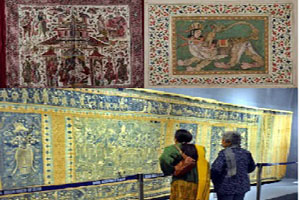
Explore the techniques of traditional Deccan embroidery at Nauras expo
YarnsandFibers News Bureau 2015-03-19 15:00:00 – New DelhiNauras: The Many Arts of the Deccan’ ongoing exhibtion organized on the embroidery works of the peninsular region at the National Museum here, depicts the art of Deccani sultanates between the 16th and 19th centuries.
Although embroidery is popular across the country, techniques used in the Deccan region are lesser known. Apart from the zari brocade and kalamkari traditions, some of the famous embroidery forms of the region are toda (Tamil Nadu), kausti (Karnataka) and banjara (Andhra Pradesh).
These embroideries were done for domestic, religious and commercial purposes and can be seen on the numerous artefacts that have been preserved and are on display at the exhibition. The intricate works provide an insight into the artist’s thought process and the user’s aesthetic sensibilities. These techniques, which evolved in medieval-era Southern India, continue to be incorporated in new-age textile embroidery, proving the strength of vintage art to reinvent itself.
Art historian Choodamani Nandagopal at the seminar said that till today the bright colours of banjara are a craze among even the younger generation of the region. The Deccani depictions of temples, chariots, palanquins and lamps have their updated representations in contemporary fabrics that are sold in the market today.
An interesting example of how traditional designs are finding their way into modern works is Kerala’s floral carpets made during Onam. Their designs are now replicated in textile items such as bed-sheets and pillow-covers.
The seminar also focused on the conservative aspects of embroidered textiles. Issues such as preventive care and methods of preserving textiles in a museum environment were addressed. Being organic in nature, textiles encounter various conservational problems such as colour fading, colour bleeding, weakness of fibres, strains, etc.
It also showcases the Shamshir sword, Khanjar and Jambia daggers of Aurangzeb, which have his name inscribed on them, apart from other paintings and objects.
The exhibition was to end on March 20 but has been extended by a month.
Market Intelligence
Ask for free sample Report

experience
Customer Base
dedicated team
Countries Served Worldwide









